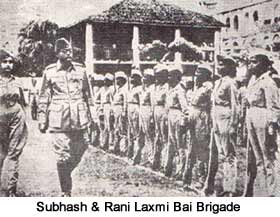

 |  |
 The second phase of the INA began when Subhash Chandra Bose reached Singapore on 2 July 1943, after meeting Hitler in Berlin, by means of German and Japanese submarines. He went to Tokyo and Prime Minister Tojo declared that Japan had no territorial designs on India. Bose returned to Singapore and set up the Provisional Government of Free India on 21 October 1943.
The second phase of the INA began when Subhash Chandra Bose reached Singapore on 2 July 1943, after meeting Hitler in Berlin, by means of German and Japanese submarines. He went to Tokyo and Prime Minister Tojo declared that Japan had no territorial designs on India. Bose returned to Singapore and set up the Provisional Government of Free India on 21 October 1943. The Provisional Government then declared war on Britain and the United States, and was recognized by the Axis powers and their satellites. Subhash Bose set up two INA headquarters, in Rangoon and in Singapore, and began to reorganize the INA. Recruits were sought from civilians, funds were gathered, and even a women's regiment called the Rani Jhansi regiment was formed. On 6 July 1944, Subhash Chandra Bose (referred to as Netaji or the Leader by his followers), in a broadcast on Azad Hind Radio addressed to Gandhiji, said: 'India's last war of independence has begun . . . Father of our Nation! In this holy war of India's liberation, we ask for your blessing and good wishes.' One INA battalion commanded by Shah Nawaz was along with the Japanese Army proceeded to the Indo-Burma front and participate in the Imphal campaign. The failure of the Imphal campaign, and the steady Japanese retreat there, quashed any hopes of the INA liberating the nation. The retreat which began in mid-1944 continued till mid-1945 and ended only with the final surrender to the British in South-East Asia. But, when the INA men were brought back home and threatened with serious punishment, a powerful movement was to emerge in their defence. next page >> |
Copyright ©2000 indiansaga.info. All rights reserved.
By using this service, you accept that you won't copy or use the data given in this website for any commercial purpose.
The material on indiansaga.info is for informational & educational purpose only.
This site is best viewed at 800 X 600 picture resolution.